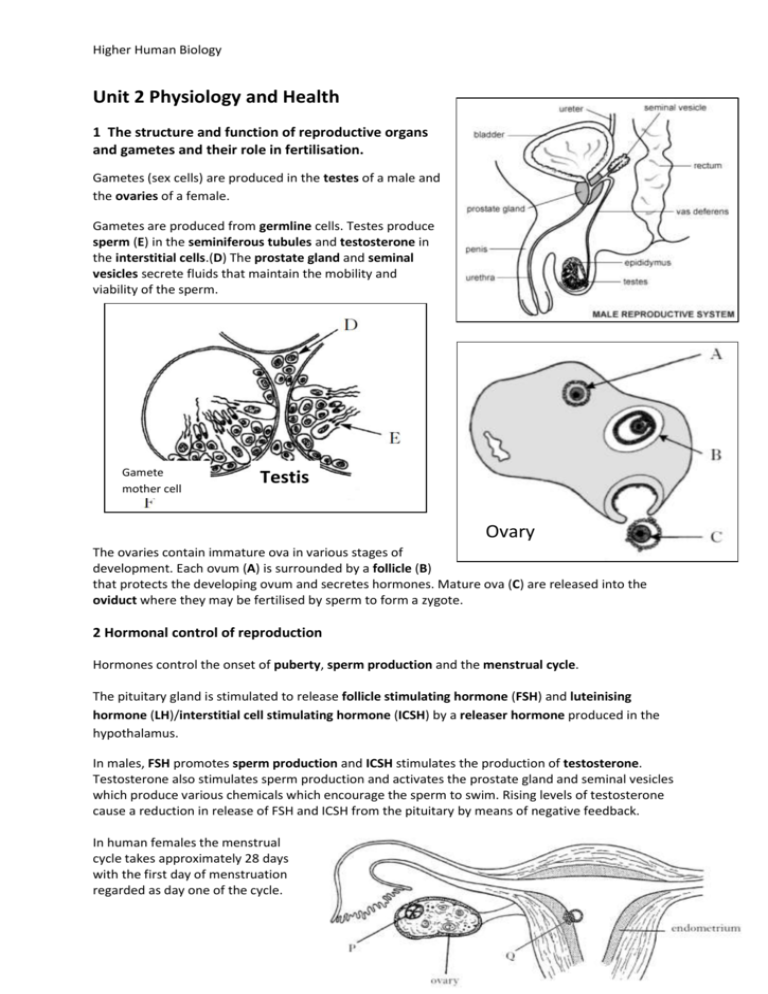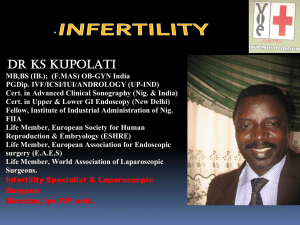physiology and health 1
advertisement

Higher Human Biology Unit 2 Physiology and Health 1 The structure and function of reproductive organs and gametes and their role in fertilisation. Gametes (sex cells) are produced in the testes of a male and the ovaries of a female. Gametes are produced from germline cells. Testes produce sperm (E) in the seminiferous tubules and testosterone in the interstitial cells.(D) The prostate gland and seminal vesicles secrete fluids that maintain the mobility and viability of the sperm. Gamete mother cell Testis Ovary The ovaries contain immature ova in various stages of development. Each ovum (A) is surrounded by a follicle (B) that protects the developing ovum and secretes hormones. Mature ova (C) are released into the oviduct where they may be fertilised by sperm to form a zygote. 2 Hormonal control of reproduction Hormones control the onset of puberty, sperm production and the menstrual cycle. The pituitary gland is stimulated to release follicle stimulating hormone (FSH) and luteinising hormone (LH)/interstitial cell stimulating hormone (ICSH) by a releaser hormone produced in the hypothalamus. In males, FSH promotes sperm production and ICSH stimulates the production of testosterone. Testosterone also stimulates sperm production and activates the prostate gland and seminal vesicles which produce various chemicals which encourage the sperm to swim. Rising levels of testosterone cause a reduction in release of FSH and ICSH from the pituitary by means of negative feedback. In human females the menstrual cycle takes approximately 28 days with the first day of menstruation regarded as day one of the cycle. Higher Human Biology FSH stimulates the development of a follicle and the production of oestrogen by the follicle in the follicular phase. Oestrogen stimulates proliferation of the endometrium in the uterus preparing it for implantation and affects the consistency of cervical mucus making it more easily penetrated by sperm. Peak levels of oestrogen stimulate a surge in the secretion of LH which triggers ovulation. In the luteal phase the follicle develops into a corpus luteum (P above) and secretes progesterone. Progesterone promotes further development and vascularisation (development of blood vessels) of the endometrium preparing it to receive a blastocyst (Q) if fertilisation occurs. The negative feedback effect of the ovarian hormones on the pituitary gland and the secretion of FSH and LH prevent further follicles from developing. If fertilisation of the ovum and implantation does not occur the lack of LH leads to degeneration of the corpus luteum with a subsequent drop in progesterone levels leading to menstruation where the endometrial lining of the uterus detaches and exits the body through the vaginal opening. 3 The biology of controlling fertility. Infertility treatments and contraception are based on the biology of fertility. (i) Fertile periods. As there is a cyclical pattern to female hormone activity there are parts of the cycle where fertilisation is more likely, i.e. from a few days before release of the ovum to a couple of days after release, and less likely, just before, during and just after the menstrual period. The fertile period occurs just before, during and after the surge in LH levels which trigger release of the ovum from the follicle and lasts for a few days. This period can be detected by an increase in blood or urine LH levels, by taking intra-vaginal temperatures or more simply by counting days after the last menstrual period. Knowledge of when she is most fertile can help a woman to both become pregnant and to avoid pregnancy by either having or avoiding intercourse at these times. Whilst knowledge of the fertile period can assist in conception not all women have regular menstrual cycles however, and there are more effective methods of contraception. In males sperm are continually produced in the testes after puberty (although production decreases in later life) and so males have continuous fertility and may be capable of fathering children into old age. Higher Human Biology (ii) Treatments for infertility. Despite the effectiveness of the process, (look how many of us there are!), not all couples are successful at conceiving a baby without assistance. Stimulating ovulation. Ovulation stimulated by drugs that prevent the negative feedback effect of oestrogen on FSH secretion. Risks and ethics associated with fertility treatments. Case studies on infertility, its causes and treatment to include overcoming problems in sperm production and ovulation, predicting fertile periods, and surgical interventions. Other ovulatory drugs mimic the action of FSH and LH. These drugs can cause super ovulation that can result in multiple births or be used to collect ova for in vitro fertilisation (IVF) programmes. Artificial insemination. Several samples of semen are collected over a period of time. If a partner is sterile a donor may be used. Artificial insemination is particularly useful where the male has a low sperm count. Intra-cytoplasmic sperm injection (ICSI). If mature sperm are defective or very low in number ICSI can be used — the head of the sperm is drawn into a needle and injected directly into the egg to achieve fertilisation. In vitro fertilisation (IVF). Surgical removal of eggs from ovaries after hormone stimulation. Incubation of zygotes and uterine implantation. Pre-implantation genetic screening to identify genetic disorders and chromosome abnormalities. The eggs are mixed with sperm in a culture dish. The fertilised eggs are incubated until they have formed at least eight cells and are then transferred to the uterus for implantation. Contraception — physical and chemical methods of contraception. Biological basis of physical methods. Chemical contraceptives are based on combinations of synthetic hormones that mimic negative feedback preventing the release of FSH/LH. Physical methods such as barrier methods, avoiding fertile periods, intra uterine devices and sterilisation procedures. Some prevent implantation (‘morning-after pills’) or cause thickening of cervical mucus (‘progesterone- only pill’). 4 Ante- and postnatal screening. (a) Antenatal screening identifies the risk of a disorder so that further tests and a prenatal diagnosis can be offered. A variety of techniques can be used to monitor the health of the mother and developing fetus. Ultrasound imaging. Anomaly scans may detect serious physical problems. Dating scans, for pregnancy stage and due date, are used with tests for marker chemicals which vary normally during pregnancy. Biochemical tests to detect the normal physiological changes of pregnancy. Measuring a substance at the wrong time could lead to a false positive result. Blood pressure, blood type and general health checks (including routine blood and urine tests). Higher Human Biology Diagnostic testing Amniocentesis and chorionic villus sampling (CVS) and the advantages and disadvantages of their use. Cells from samples can be cultured to obtain sufficient cells to produce a karyotype to diagnose a range of conditions. Medical conditions can be detected by a range of marker chemicals that indicate a condition but need not necessarily be part of the condition, e.g. if Down’s syndrome is suspected the blood can be tested for elevated levels of alpha-fetoprotein (AFP). As a result of routine screening or for individuals in high risk categories, further tests may be offered. In deciding to proceed with these tests, the element of risk will be assessed as will the decisions the individuals concerned are likely to make if a test is positive. Tests may include amniocentesis and CVS from the placenta. CVS can be carried out earlier in pregnancy than amniocentesis. Although it has a higher risk of miscarriage CVS karyotyping can be performed on the foetal cells immediately. Examine data on the risks associated with testing for Down’s syndrome. Blood test for alphafetoprotein (AFP) and subsequent test for the ‘marker’ nuchal translucency by ultrasound. If the results indicate a high risk of Down’s syndrome further diagnostic tests with more risk may be offered. Construct karyotypes of fetal material which indicate a variety of genetic disorders. Suitable examples include: Down’s trisomy, Edward’s trisomy, Klinefelter’s/Turner’s syndromes, Familial Down’s, Fragile X, Cri-du-chat. Rhesus antibody testing. Anti-rhesus antibodies are given to rhesus-negative mothers after a sensitising event or after birth. Generally mothers show no immune response to their fetus although sensitisation to Rhesus antigens can occur. (b) Postnatal screening. Diagnostic testing for metabolic disorders, including phenylketonuria (PKU), an inborn error of metabolism. Individuals with high levels of phenylalanine are placed on a restricted diet. New-born screening for other diseases such as galactosaemia, congenital hypothyroidism, amino acid disorders. The use of pedigree charts to analyse patterns of inheritance in genetic screening and counselling. Patterns of inheritance in autosomal recessive, autosomal dominant, incomplete dominance and sex-linked recessive single gene disorders. Examine case studies of inherited conditions including single gene disorders, chromosome abnormalities and conditions influenced by multiple genes. Higher Human Biology Calculate probability of outcomes in single gene inherited conditions. Suitable examples include: albinism, Huntington’s chorea, sickle cell, thalassaemia, haemophilia, muscular dystrophy. Draw, analyse and interpret pedigree charts over three generations to follow patterns of inheritance in genetic disorders using standardised human pedigree nomenclature and symbols (sex, matings, siblings, affected individuals, twins, heterozygotes, carrier of sex-linked allele and deceased).









